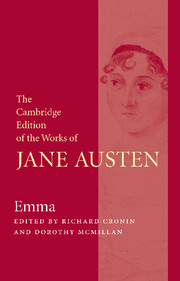Chapter 11
Published online by Cambridge University Press: 18 December 2020
Summary
IT may be possible to do without dancing entirely. Instances have been known of young people passing many, many months successively, without being at any ball of any description, and no material injury accrue either to body or mind;— but when a beginning is made—when the felicities of rapid motion have once been, though slightly, felt—it must be a very heavy set that does not ask for more.
Frank Churchill had danced once at Highbury, and longed to dance again; and the last half hour of an evening which Mr. Woodhouse was persuaded to spend with his daughter at Randalls, was passed by the two young people in schemes on the subject. Frank's was the first idea; and his the greatest zeal in pursuing it; for the lady was the best judge of the difficulties, and the most solicitous for accommodation and appearance. But still she had inclination enough for shewing people again how delightfully Mr. Frank Churchill and Miss Woodhouse danced—for doing that in which she need not blush to compare herself with Jane Fairfax—and even for simple dancing itself, without any of the wicked aids of vanity—to assist him first in pacing out the room they were in to see what it could be made to hold—and then in taking the dimensions of the other parlour, in the hope of discovering, in spite of all that Mr. Weston could say of their exactly equal size, that it was a little the largest.
His first proposition and request, that the dance begun at Mr. Cole's should be finished there—that the same party should be collected, and the same musician engaged, met with the readiest acquiescence. Mr. Weston entered into the idea with thorough enjoyment, and Mrs. Weston most willingly undertook to play as long as they could wish to dance; and the interesting employment had followed, of reckoning up exactly who there would be, and portioning out the indispensable division of space to every couple.
- Type
- Chapter
- Information
- Emma , pp. 266 - 276Publisher: Cambridge University PressPrint publication year: 2005

